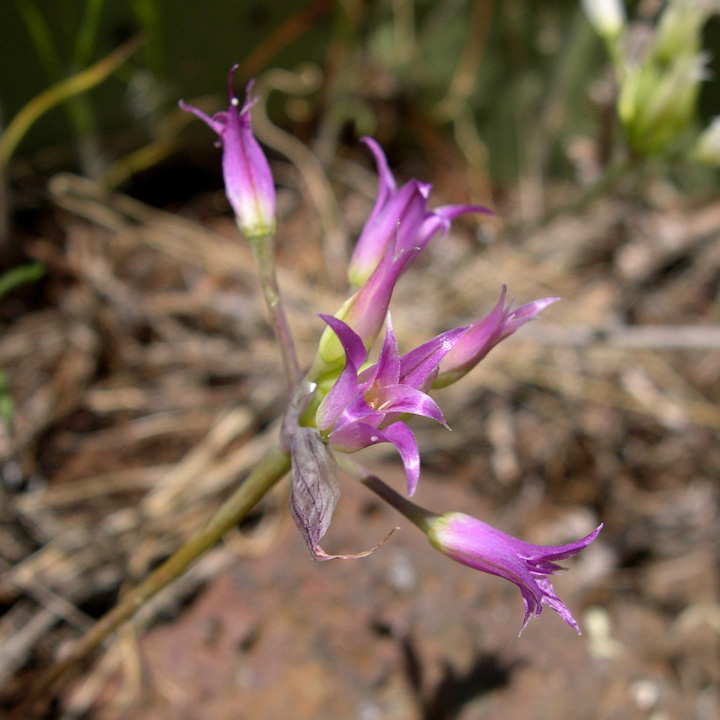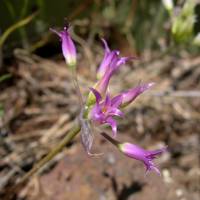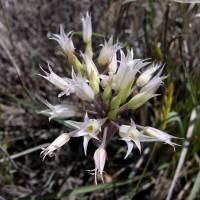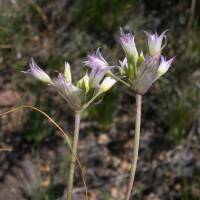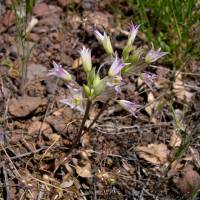Bulbs 1-12+, not basally clustered, not forming rhizomes, ovoid to ± globose, 0.8-1.6 × 0.9-1.6 cm; outer coats enclosing 1 or more renewal bulbs, ± yellow-brown, prominently cellular-reticulate, membranous, cells square or polygonal, walls thick, obscurely sinuous, without fibers; inner coats white, cells obscure, ± quadrate. Leaves persistent, withering from tip by anthesis, 2-3, basally sheathing, sheaths not extending much above soil surface; blade solid, subterete or ± channeled, 7-30 cm × 1-3 mm, margins entire. Scape persistent, solitary, erect, solid, terete, 10-35 cm × 1-3 mm. Umbel persistent, erect, loose, 10-40-flowered, hemispheric, bulbils unknown; spathe bracts persistent, 2, 3-7-veined, lanceolate to ovate, ± equal, apex acuminate. Flowers campanulate, 8-15 mm; tepals erect, pink to rose-purple, or white, lanceolate to lance-ovate, unequal, becoming rigid and keeled in fruit, margins finely denticulate (inner tepal more prominently so), apex acuminate, outer tepal longer and wider than inner, spreading to recurved at tip, inner tepal with strongly recurved tips; stamens included; anthers yellow; pollen yellow; ovary crested; processes 3, central, 2-lobed, rounded, minute, margins entire; style linear, equaling stamens; stigma capitate, scarcely thickened, obscurely 3-lobed; pedicel 6-25 mm. Seed coat dull or shining; cells minutely roughened. 2n = 14.
Flowering Apr--Jul. Dry slopes and plains; 100--1500 m; B.C.; Ariz., Calif., Colo., Idaho, Nev., Oreg., Utah, Wash., Wyo.
Duration: Perennial
Nativity: Native
Lifeform: Forb/Herb
General: Perennial monocot with 1-12 bulbs, not basally clustered and not forming rhizomes; bulbs ovoid to globose 0.8-1.6 cm by 0.9-1.6 cm; outer coats yellow-brown, membranous with thick walls, inner coats white.
Leaves: Persistent, withering from tip at anthesis, 2-3, basally sheathing, not extending much above soil surface; blade solid, subterete to channeled, 7-30 cm long by 1-3 mm wide, with entire margins.
Flowers: On persistent scape, solitary and erect, 10-35 cm tall; topped by persistent erect umbel, loose, with 10-40 flowers, hemispheric, no bulbils, spathe bracts persistent, 2, those 3-7 veined; flowers campanulate, 8-15 mm, tepals erect, pink to rose-purple or white, lanceolate to lance-ovate, unequal, becoming rigid and keeled in fruit, margins spreading to recurved at tip, inner tepal with strongly recurved tips.
Fruits: Capsule 3-4 mm long with minutely roughened coat and 3 inconspicuous crests.
Ecology: Found on dry slopes from 2,000-7,000 ft (610-2134 m); flowers April-July.
Distribution: Widespread west of the Rockies.
Notes: Distinguished from the similar A. biseptrum by its unequal flower segments which also have recurved tips, along with the concave leaves and thick yellow-brown coat of the bulb.
Ethnobotany: Bulbs and leaves were eaten, bulbs were also rubbed on skin to deter insects.
Etymology: Allium is Latin for garlic, while acuminatum means having a long tapering point.
Synonyms: Allium acuminatum var. cuspidatum
Editor: SBuckley, 2010


